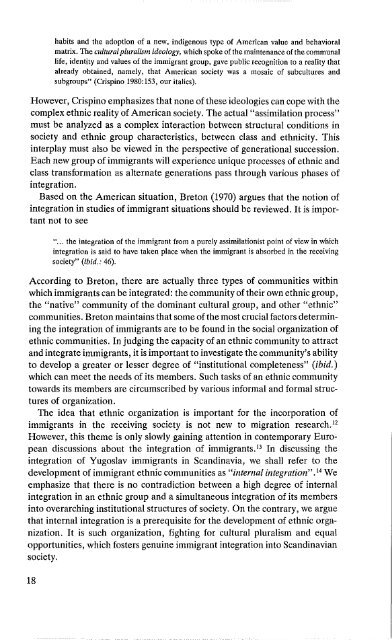Will they still be dancing? (1982)
Etnographic study of Romanians from East Serbia in Sweden in 1980s
Etnographic study of Romanians from East Serbia in Sweden in 1980s
Create successful ePaper yourself
Turn your PDF publications into a flip-book with our unique Google optimized e-Paper software.
habits and the adoption of a new, indigenous type of American value and <strong>be</strong>havioral<br />
matrix. The culturalpluralism ideology, which spoke ofthe maintenance ofthe communal<br />
life, identity and values of the immigrant group, gave public recognition to a reality that<br />
already obtained, namely, that American society was a mosaic of subcultures and<br />
subgroups" (Crispino 1980:153, our italics).<br />
However, Crispino emphasizes that none ofthese ideologies can cope with the<br />
complex ethnic reality of American society. The actual "assimilation process"<br />
must <strong>be</strong> analyzed as a complex interaction <strong>be</strong>tween structural conditions in<br />
society and ethnic group characteristics, <strong>be</strong>tween class and ethnicity. This<br />
interplay must also <strong>be</strong> viewed in the perspective of generational succession.<br />
Each new group of immigrants will experience unique processes of ethnic and<br />
class transformation as alternate generations pass through various phases of<br />
integration.<br />
Based on the American situation, Breton (1970) argues that the notion of<br />
integration in studies of immigrant situations should <strong>be</strong> reviewed. It is important<br />
not to see<br />
"... the integration of the immigrant from a purely assimilationist point of view in which<br />
integration is said to have taken place when the immigrant is absor<strong>be</strong>d in the receiving<br />
society" (ibid.: 46).<br />
According to Breton, there are actually three types of communities within<br />
which immigrants can <strong>be</strong> integrated: the community of their own ethnic group,<br />
the "native" community of the dominant cultural group, and other "ethnic"<br />
communities. Breton maintains that some ofthe most crucial factors determining<br />
the integration of immigrants are to <strong>be</strong> found in the social organization of<br />
ethnic communities. In judging the capacity of an ethnic community to attract<br />
and integrate immigrants, it is important to investigate the community's ability<br />
to develop a greater or lesser degree of "institutional completeness" (ibid.)<br />
which can meet the needs of its mem<strong>be</strong>rs. Such tasks of an ethnic community<br />
towards its mem<strong>be</strong>rs are circumscri<strong>be</strong>d by various informal and formal structures<br />
of organization.<br />
The idea that ethnic organization is important for the incorporation of<br />
immigrants in the receiving society is not new to migration research. l '<br />
However, this theme is only slowly gaining attention in contemporary European<br />
discussions about the integration of immigrants. 13 In discussing the<br />
integration of Yugoslav immigrants in Scandinavia, we shall refer to the<br />
development of immigrant ethnic communities as "internal integration" .14 We<br />
emphasize that there is no contradiction <strong>be</strong>tween a high degree of internal<br />
integration in an ethnic group and a simultaneous integration of its mem<strong>be</strong>rs<br />
into overarching institutional structures of society. On the contrary, we argue<br />
that internal integration is a prerequisite for the development of ethnic organization.<br />
It is such organization, fighting for cultural pluralism and equal<br />
opportunities, which fosters genuine immigrant integration into Scandinavian<br />
society.<br />
18
















